How to Grow Cherimoya Tree
- March 21, 2024
- 0 comment
Learn how to grow a Cherimoya tree (Annona cherimola) with our comprehensive guide. Discover tips for cultivating this subtropical fruit with a sweet, creamy texture and unique flavor. Often described as a blend of banana, pineapple, and strawberry, cherimoya is not just a delightful fruit but also an attractive tree for garden enthusiasts. Here’s a comprehensive guide on how to grow a cherimoya tree.
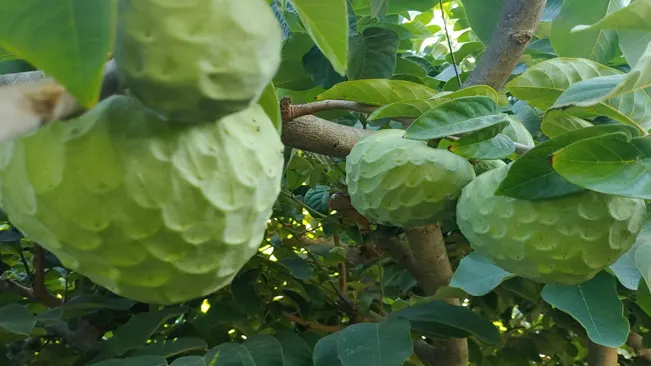
Benefits of Cherimoya Tree
| Benefit | Description |
|---|---|
| Nutritional Value | Cherimoya is rich in vitamins C and B6, fiber, and essential minerals like potassium, magnesium, and copper. |
| Antioxidant Properties | Contains antioxidants like vitamin C, which help combat free radicals and reduce oxidative stress. |
| Heart Health | The potassium in cherimoya helps regulate blood pressure, contributing to heart health. |
| Immune Support | High vitamin C content boosts the immune system and improves overall health. |
| Digestive Health | The dietary fiber in cherimoya aids in digestion and helps prevent constipation. |
| Anti-inflammatory | Contains compounds that have anti-inflammatory properties, beneficial for reducing inflammation. |
| Cancer Prevention | Some studies suggest that the compounds in cherimoya may have anti-cancer properties. |
| Weight Management | Low in calories and high in fiber, making it a suitable addition to weight loss diets. |
| Mood Enhancement | Vitamin B6 in cherimoya helps in the production of neurotransmitters, which can enhance mood. |
| Skin Health | Vitamin C contributes to collagen production, essential for skin health and elasticity. |
List on How To Grow Cherimoya Tree
- Understanding the Basics
- Planting Cherimoya
- Caring for Your Cherimoya Tree
- Pollination
- Harvesting
- Pest and Disease Management
Understanding the Basics
Origin
- Geographical Roots: The cherimoya tree, Annona cherimola, has its origins in the Andes mountains, specifically in regions now part of Ecuador, Colombia, Peru, and Bolivia. This Andean region provides a unique environment that has shaped the tree’s adaptability and needs.
Climate Needs
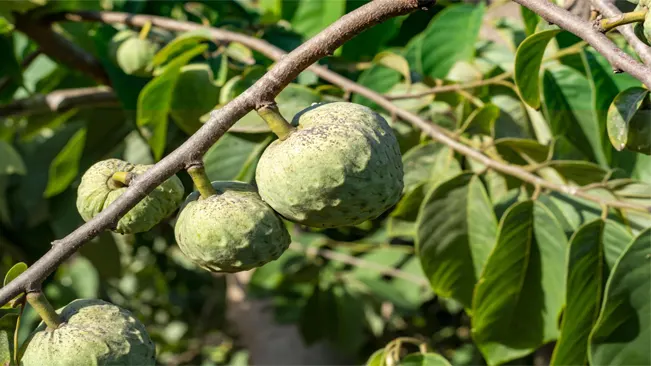
- Temperature Range: Cherimoya trees prefer a mild, subtropical climate. They grow best in areas where temperatures are consistently between 65°F and 85°F (18°C to 29°C). This range ensures the optimal balance for growth, flowering, and fruit development.
- Frost Sensitivity: One of the key vulnerabilities of the cherimoya tree is its sensitivity to frost. Temperatures below 32°F (0°C) can cause significant damage to the tree. Frost can impair blossom and young fruit development, leading to lower yields.
- Heat Tolerance: While cherimoya trees enjoy warmth, extreme heat can be detrimental, especially when coupled with low humidity. Prolonged exposure to temperatures above 90°F (32°C) can stress the tree, affecting its growth and fruit quality.
- Wind Protection: In their native Andean environment, cherimoya trees are often shielded from strong winds by the natural landscape. In cultivation, they require similar protection. Strong winds can damage branches, disrupt pollination, and cause fruit to fall prematurely. Windbreaks or strategic planting near buildings or other trees can offer necessary protection.
- Humidity Requirements: Cherimoya trees thrive in areas with moderate to high humidity. Low humidity levels can impact pollination success and fruit set. In dryer climates, providing additional moisture through regular watering or misting can be beneficial.
Planting Cherimoya
Site Selection
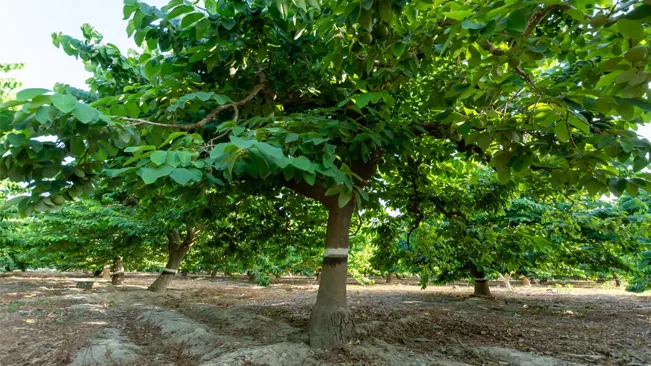
- Sunlight: Cherimoya trees need an area that receives full sun for the majority of the day. Aim for a location that gets at least 6 to 8 hours of direct sunlight daily. While they can manage with partial shade, full sun exposure ensures optimal growth and fruiting.
- Wind Protection: These trees are somewhat fragile and can be damaged by strong winds. If possible, choose a site that is sheltered from prevailing winds or consider installing a windbreak.
- Accessibility for Maintenance: Consider the ease of accessing the tree for regular maintenance tasks like pruning, watering, and harvesting.
Soil Requirements
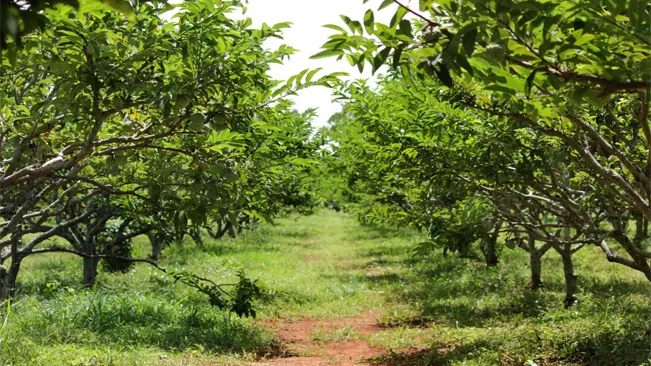
- Texture and Composition: Rich, loamy soil is ideal because it holds nutrients well while allowing excess water to drain. The texture should be moderately loose, allowing for good root growth and air circulation.
- Drainage: Cherimoya trees cannot tolerate standing water. Ensure that the chosen location does not collect water after rain. You might need to improve the drainage by amending the soil or planting on a slight mound.
- Soil pH: The optimal pH range is slightly acidic to neutral (pH 6.0 to 7.5). If you’re unsure of your soil pH, consider getting a soil test from a local garden center and adjust the pH accordingly using lime (to increase pH) or sulfur (to decrease pH).
Planting Process
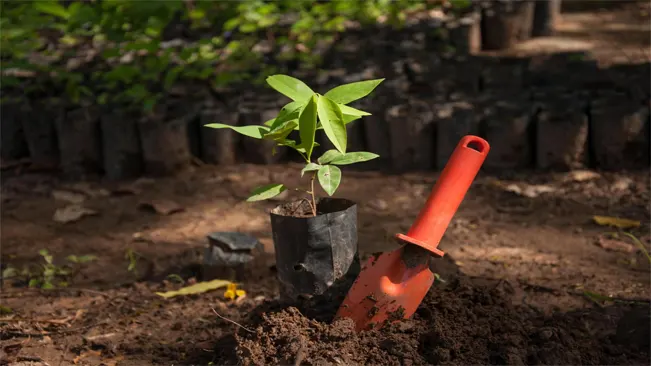
- Hole Preparation: Dig a hole that is twice as wide and deep as the root ball of your sapling. This ensures the roots have enough room to spread and grow.
- Soil Enrichment: Before planting, mix in organic matter such as compost or aged manure into the excavated soil. This will provide essential nutrients and improve soil structure.
- Planting the Sapling: Place the tree in the center of the hole, ensuring that it’s sitting at the same depth it was in the pot. The top of the root ball should be level with the surrounding ground.
- Backfilling: Gently backfill the hole with the enriched soil, tamping down lightly as you go to remove air pockets. Do not compress the soil too heavily.
- Watering: After planting, water the tree thoroughly to settle the soil around the roots. This also helps to eliminate any remaining air pockets.
- Mulching: Apply a layer of organic mulch around the base of the tree (but not touching the trunk) to conserve moisture and suppress weeds.
Caring for Your Cherimoya Tree
Watering
- Frequency: During the active growth period (spring and summer), water the cherimoya tree once or twice a week. The goal is to maintain a balance where the soil is moist but not waterlogged.
- Amount: Apply approximately 1-2 inches of water each time. This can vary based on soil type and climate conditions. Sandy soils require more frequent watering than clay soils.
- Method: Water slowly at the base of the tree to ensure deep soil penetration. Avoid wetting the foliage to reduce disease risk.
- Winter Care: Reduce watering in the winter when the tree is dormant. Water lightly every few weeks to prevent the soil from completely drying out.
Fertilizing
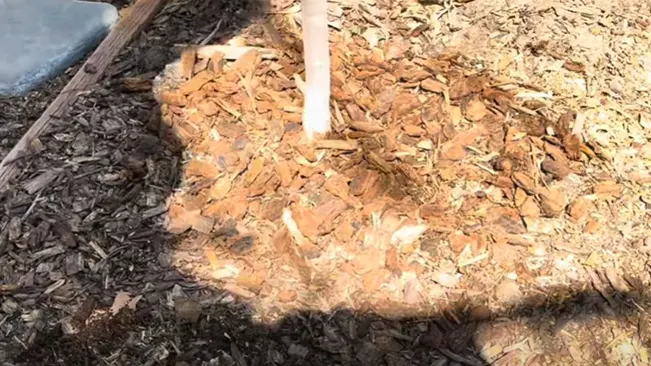
- Type of Fertilizer: Use a balanced, slow-release fertilizer with equal parts nitrogen, phosphorus, and potassium (e.g., 10-10-10 NPK).
- Frequency: Fertilize young trees every two to three months during the growing season. Mature trees can be fertilized once in early spring and again in mid-summer.
- Application: Apply fertilizer around the drip line of the tree, not directly against the trunk. Water the tree after applying fertilizer to help it soak into the soil.
- Organic Options: Supplement with organic matter like compost or aged manure in the spring. This not only provides nutrients but also improves soil structure and health.
Pruning
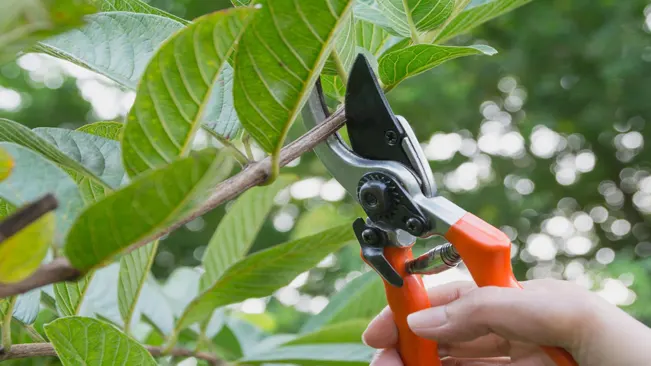
- Time to Prune: The best time to prune a cherimoya tree is in late winter or early spring before new growth starts.
- Pruning Technique:
- Remove any dead, diseased, or damaged branches first.
- Thin out crowded branches to improve light penetration and air flow within the canopy.
- Cut back overly vigorous, upright shoots and any branches that cross or rub against each other.
- Maintain a balanced shape, keeping the center of the tree open to sunlight.
- Tools: Use sharp, clean pruning shears for small branches and a pruning saw for larger limbs. Disinfect your tools before and after use to prevent the spread of disease.
Pollination
Cherimoya trees have unique flowers that are hermaphroditic but self-incompatible, meaning they require cross-pollination. Hand pollination often yields the best fruit set. Collect pollen from a flower in the male stage and transfer it to a flower in the female stage using a small brush.
- Hermaphroditic Nature: Each cherimoya flower contains both male and female reproductive parts. However, these parts are not active at the same time, which is why cherimoya trees are self-incompatible.
- Stages of Flower Development: The flower goes through distinct stages. Initially, it opens in a female phase, where the stigma (female part) is receptive. After about 24-36 hours, the flower shifts to the male phase, where the stamens (male parts) release pollen.
Hand Pollination Process
- Timing: Identify flowers in the male and female stages. The female stage is characterized by an open flower with a sticky stigma. The male stage is when the stamens are releasing pollen, which usually occurs a day after the female stage.
- Collecting Pollen:
- During the male phase, usually in the afternoon, collect pollen from the flower. This can be done by gently brushing the stamens with a small, soft brush or cotton swab to gather pollen.
- Store the pollen in a cool, dry place if not using immediately. It can be kept for a day or two without significant loss of viability.
- Pollinating Female Flowers:
- Return to the tree during the morning when female-phase flowers are present.
- Using the brush with the collected pollen, gently touch the stigma of the female-phase flowers. Ensure that a good amount of pollen makes contact with the sticky stigma.
- Repeat Process: Since not all flowers open at the same time, visit your tree daily to check for new flowers in the female stage and repeat the pollination process.
Tips for Successful Pollination
- Environmental Factors: Cooler, overcast days can extend the female receptive stage, providing a longer window for pollination.
- Multiple Trees: If possible, having more than one cherimoya tree can increase the chances of successful pollination due to the greater number of flowers in different stages.
- Record-Keeping: Keeping track of which flowers have been pollinated can help monitor the success rate and improve techniques.
Harvesting
Cherimoyas are ready to harvest when they yield slightly to gentle pressure. The skin may turn a slight yellow or brownish tone. They should be harvested with care as they bruise easily.
Timing
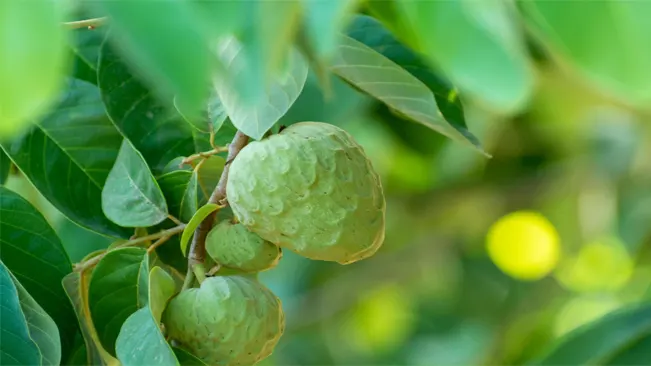
- Cherimoyas typically ripen in the fall or winter, depending on the local climate. The exact timing of harvest can vary based on the specific variety and growing conditions.
Indicators of Ripeness
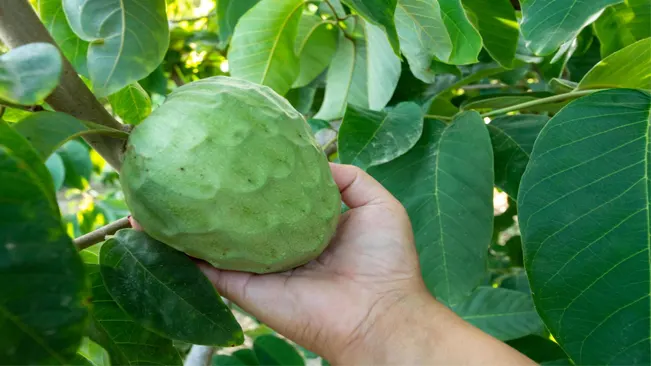
- Texture: Mature cherimoyas will yield slightly to gentle pressure, similar to a ripe avocado. It’s crucial not to apply too much force to avoid bruising.
- Color Change: The skin color changes from green to a more yellowish or light brown tone. Some varieties might develop a slight give without much color change, so it’s important to consider both texture and color.
- Stem Area: The area around the stem may soften slightly, indicating readiness for harvest.
- Fruit Size: While size can vary, cherimoyas usually reach their full size before they start to ripen.
Harvesting Technique
- Use pruning shears or a sharp knife to cut the fruit stem from the tree. It’s advisable to leave a short stem attached to the fruit.
- Handle the fruit gently to avoid bruising or damaging the skin. Cherimoyas are delicate and can be easily damaged during harvest and post-harvest handling.
Post-Harvest Handling
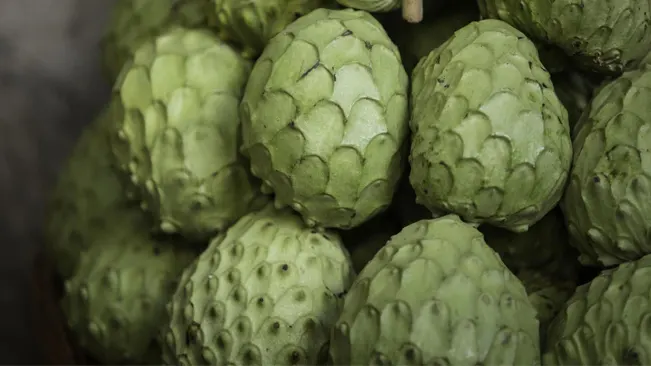
- After harvesting, cherimoyas can be left at room temperature to fully ripen. This usually takes a few days.
- The fruit is ripe when it feels soft to the touch. Once ripe, it should be eaten within a day or two, or it can be stored in the refrigerator for a short period to extend its shelf life.
- Be cautious not to chill unripe fruits, as this can hinder their ripening process.
Storage
- Ripe cherimoyas can be stored in the refrigerator for up to 4 days. It’s important to keep them in a place where they won’t be squashed or bruised by other items.
Pest and Disease Management
Watch out for pests like aphids and scale insects. Regular inspections and natural remedies like neem oil can be effective. Fungal diseases can be prevented by ensuring good air circulation and avoiding overhead watering.
Pest Management
- Aphids: Small, sap-sucking insects that can cause leaf curling and stunted growth.
- Control: Use a strong water spray to dislodge them or apply insecticidal soap. Introducing natural predators like ladybugs can also be effective.
- Scale Insects: These pests attach themselves to stems and leaves, draining the plant’s fluids.
- Control: Scrape them off manually or use horticultural oil for treatment. Neem oil is also effective in controlling scale infestations.
- Mealybugs: They are similar to aphids and can cause leaf yellowing and wilting.
- Control: Remove them manually with a cotton swab dipped in alcohol or apply insecticidal soap.
Disease Management
- Fungal Diseases (like Anthracnose): These can cause dark lesions on fruits, leaves, and branches.
- Control: Ensure good air circulation by proper pruning. Avoid overhead watering to keep foliage dry. Fungicides may be required for severe infections.
- Root Rot: Often a result of overwatering and poor drainage.
- Control: Ensure well-draining soil and moderate watering. Avoid letting the tree sit in waterlogged soil.
- Powdery Mildew: Appears as white, powdery spots on leaves and stems.
- Control: Increase air circulation around the tree. Apply sulfur-based or biological fungicides as needed.
Conclusion
Growing a cherimoya tree can be a rewarding experience for any gardener. With the right care, you can enjoy not only the lush greenery of the tree but also the delicious fruits that taste like a tropical blend of several popular fruits. Patience, care, and a bit of gardening know-how are all you need to successfully grow and enjoy your own cherimoya tree.
FAQs (Frequently Asked Questions)
- What climate is best for a cherimoya tree?
Cherimoya trees thrive in mild subtropical climates, with ideal temperatures ranging between 65°F to 85°F (18°C to 29°C). They are sensitive to frost and need protection from extreme cold. - How much sunlight does a cherimoya tree need?
A cherimoya tree prefers full sun but can tolerate some shade. Ensure it receives at least six hours of direct sunlight daily. - What type of soil is suitable for cherimoya trees?
Loamy, well-draining soil with a slightly acidic to neutral pH is ideal. Good drainage is crucial to prevent root rot. - How often should I water my cherimoya tree?
Water regularly to keep the soil consistently moist, especially during the growing season. Reduce watering in the winter and avoid waterlogging the soil. - Do I need to fertilize a cherimoya tree?
Yes, use a balanced fertilizer during the growing season.
Organic compost or aged manure can also be beneficial. - How do I pollinate a cherimoya tree?
Cherimoya trees require cross-pollination as they are self-incompatible. Hand pollination, using a small brush to transfer pollen from male to female flowers, is often necessary for fruit set. - When and how should I prune a cherimoya tree?
Prune in late winter to remove dead or overlapping branches. This improves sunlight penetration and air circulation, promoting better health and fruiting. - How long does it take for a cherimoya tree to bear fruit?
A cherimoya tree typically starts to bear fruit 3-5 years after planting, depending on the growing conditions and tree care. - What are common pests and diseases affecting cherimoya trees?
Common issues include aphids, scale insects, and fungal diseases. Regular inspections and treatments like neem oil can manage pests, while proper air circulation helps prevent fungal infections. - Can I grow a cherimoya tree in a pot?
Yes, cherimoya trees can be grown in large pots with proper drainage. However, they may require more frequent watering and fertilizing compared to ground planting.
For more expert gardening and advice, explore our guides, discover top recommendations in our best section, and delve into in-depth product reviews in our review section. Happy Gardening.

Kristine Moore
Forestry AuthorI'm Kristine Moore, a seasoned garden landscaping professional with over 30 years of experience. My extensive career has been dedicated to transforming outdoor spaces into stunning, sustainable landscapes. With a deep understanding of horticulture, design principles, and environmental stewardship, I have become a respected figure in the field, known for creating harmonious, visually appealing, and eco-friendly gardens. My commitment to excellence and continuous learning in landscaping trends and techniques has solidified my reputation as an expert in garden design and implementation.







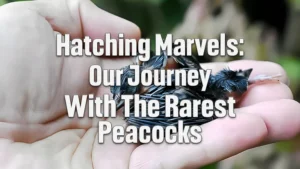

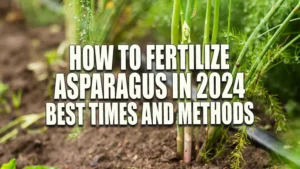



Leave your comment